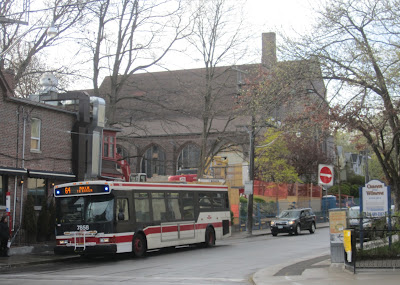At Beach United Church, we believe we are called to care for the earth and its resources, creation and all living creatures. Our construction project is an opportunity to put that belief into action.
Planting New Trees
We've been working with the recommendations of an arborist and the City of Toronto to protect all the trees on the site during construction. Especially during construction, the trees are being protected by separating them with an 8-foot plywood hoarding and a bed of woodchips. One tree, a black locust on the southeast corner of our property, is being taken down with the City's permission, as it was impossible to protect it during the demolition work. We will plant three replacement trees in Spring 2013.
Generating Alternative Energy
One of our goals with the renovation is to reduce our environmental footprint. For a start, we're reducing our physical footprint (by demolishing the south wing of the building). In addition, we've been planning a solar installation on the south side of our pitched roof. Based on information from the Ministry of the Environment, Greenpeace and the International Panel on Climate Change, a solar pv installation the size of Beach United's proposal can:
- reduce carbon dioxide emissions by approximately 35 tonnes each year going forward
- provide equivalent environmental benefits of planting over 170 trees annually in this area
- reduce equivalent emissions of over 50,000 km driven on our roads each yea
Protecting Chimney Swifts
One of our Beach neighbours alerted us that a family of chimney swifts - a threatened species in Ontario - appeared to have been nesting in an unused chimney on our north building last summer. Our original plans called for demolishing this chimney, as it casts a shadow which would reduce our rooftop solar collection by 20%. No one ever said environmental stewardship was easy!
We've been consulting with the Ministry of Natural Resources and Bird Studies Canada on how to proceed.
Chimney swifts are an interesting species. This insect-eating bird once nested primarily in hollow trees, and then adapted to human settlement by nesting in chimneys. Now chimneys are less common, use of pesticides have eliminated insects which are an important food source, and the chimney swift population is declining. Surprisingly, even though humans and swifts have been sharing the same address for a few centuries, there's still a lot to be learned about our feathered neighbours.
 |
| View of Beach United Church from the south side of Queen Street East on April 24, 2012. |

No comments:
Post a Comment
Thank you for your interest in the BUC HOMe project! We welcome your thoughts and suggestions about our redesigned church. (Please note that comments will be moderated before they are published.)